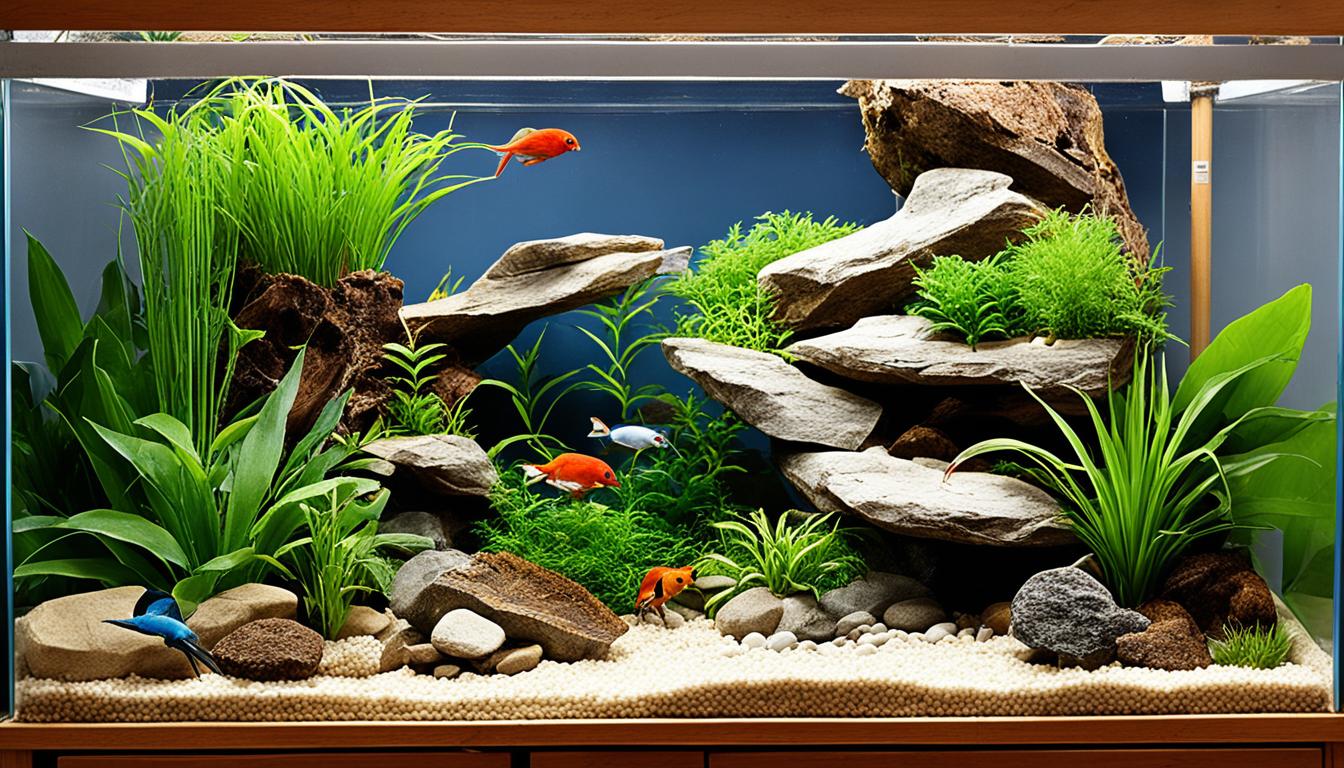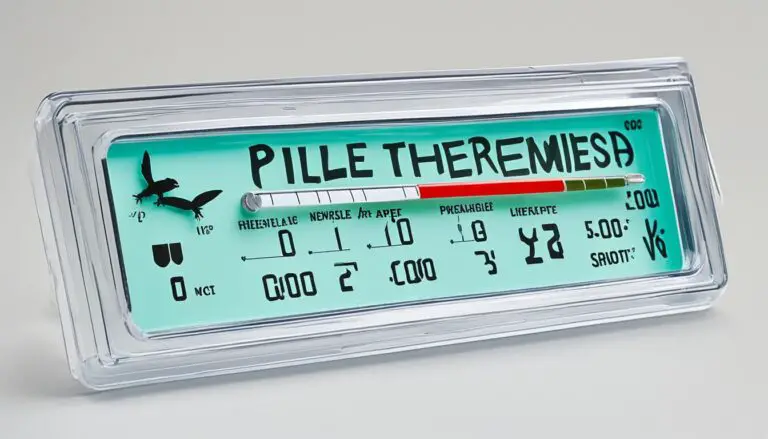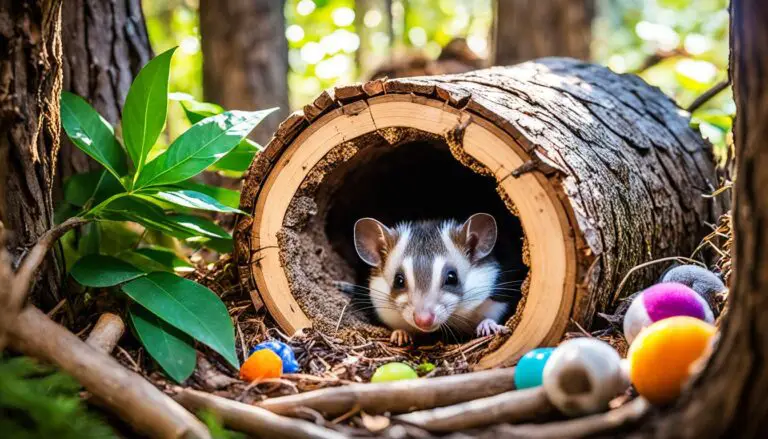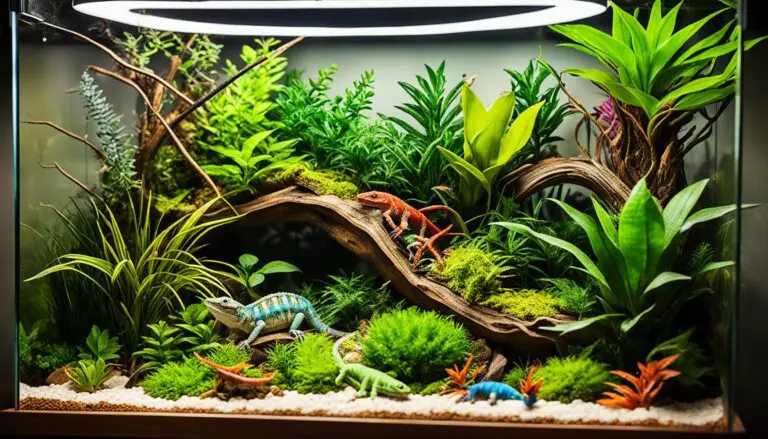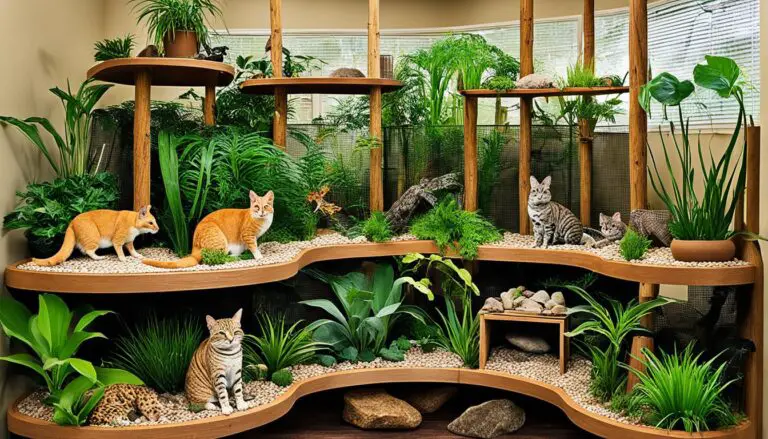Ideal Exotic Pet Housing Size Guidelines
Providing the right housing size for your exotic pet is crucial for their health and well-being. Researching your pet’s natural habitat and choosing the appropriate enclosure are important steps in creating an ideal habitat.
Key Takeaways:
- Choosing the appropriate exotic pet enclosure size is essential for the well-being of your pet.
- Research your exotic pet’s natural habitat to understand their specific needs.
- Consider factors like size, material, and design when selecting the right enclosure.
- Provide proper lighting, temperature, and substrates that mimic their natural environment.
- Maintain a clean and healthy habitat for your exotic pet’s overall well-being.
Researching Your Pet’s Natural Habitat
Before creating a habitat for your exotic pet, it’s important to thoroughly research their natural environment. Understanding their native habitat requirements is essential in providing them with a suitable and enriching living space. By replicating their natural conditions, you can support their physical and mental well-being. To accomplish this, consider factors such as climate, temperature, humidity, vegetation, and other elements specific to their species.

By researching the natural habitat of your exotic pet, you gain valuable insights into their specific needs and preferences. This knowledge allows you to recreate their habitat within their enclosure, promoting their overall health and happiness. It also helps your pet to engage in natural behaviors and thrive in their new home.
For instance, if you have a tropical reptile like the Green Iguana, understanding the high humidity levels and lush vegetation in their natural habitat will help you create a similar environment for them. This may involve providing a misting system and incorporating live plants into their enclosure.
Researching your pet’s natural habitat is a critical step in creating an exotic pet habitat that closely mimics their native environment. By understanding the conditions they are accustomed to, you can ensure a comfortable and healthy home for your unique pet.
Choosing the Right Enclosure
When it comes to providing a suitable home for your exotic pet, selecting the right enclosure is crucial. This ensures that your pet has enough space to move, explore, and engage in natural behaviors. To make an informed decision, consider the appropriate size, material, and design for the enclosure. Different exotic animals have different needs, with some requiring vertical space while others prefer horizontal space. Researching the specific requirements of your pet’s species is key in selecting the perfect enclosure.
Size Matters
The size of the enclosure is one of the most important factors to consider. It should provide ample room for your pet to move around comfortably. A restrictive enclosure can lead to stress, behavioral issues, and even health problems. Research the ideal size for your pet’s species and ensure that the dimensions meet their specific needs. A spacious enclosure allows for natural behaviors like climbing, burrowing, and exploring, promoting their physical and mental well-being.
Material Selection
The material of the enclosure is another crucial consideration. It should be sturdy, safe, and easy to clean. Common materials used for exotic pet enclosures include glass, PVC, wood, and metal. Each material has its own advantages and disadvantages, so choose one that suits your pet’s needs and your requirements. For example, glass enclosures offer better visibility, while PVC enclosures are lightweight and easy to maintain. Ensure that the material chosen does not contain any toxic substances that may harm your pet.
Design for Comfort
The design of the enclosure plays a significant role in your pet’s overall comfort. Some species prefer a more open layout, while others require hideaways or climbing structures. Consider incorporating features like branches, platforms, or multiple levels to cater to your pet’s natural behaviors. Additionally, ensure that the enclosure has proper ventilation to maintain optimal air quality. The design should also allow for easy access during cleaning and maintenance.
By selecting an enclosure that is the appropriate size, made from a suitable material, and designed with your pet’s needs in mind, you can provide them with a comfortable and stimulating habitat. Remember to research the specific requirements of your pet’s species to ensure that their enclosure meets all their unique needs.
Providing Proper Lighting and Temperature
Lighting and temperature are crucial elements in creating an optimal habitat for your exotic pet. These factors play a significant role in their health, well-being, and overall quality of life. Specifically, reptiles, for instance, require specific UVB lighting to support their calcium metabolism, which is essential for their bone health. Additionally, maintaining the right temperature gradient within the enclosure is vital for proper digestion and physiological functions.
Investing in high-quality lighting and heating equipment ensures that your exotic pet receives the necessary light and warmth to thrive. Proper lighting not only promotes their metabolic processes but also mimics the natural sunlight they would receive in their native habitats. UVB lighting, in particular, helps reptiles synthesize Vitamin D3, which is essential for calcium absorption.
To create a suitable temperature gradient, it is important to provide both a warm basking area and cooler areas within the enclosure. This allows your pet to regulate their body temperature, seeking warmth when needed and finding cooler spots for thermoregulation. Monitoring the temperature closely and adjusting as needed ensures that your pet remains comfortable and healthy.
Remember to research the specific lighting and temperature requirements of your exotic pet’s species. Different species have varying needs, and it’s important to tailor the lighting and heating setup accordingly. Consulting with a veterinarian specializing in exotic animals can provide valuable guidance in ensuring that your pet’s lighting and temperature needs are met.

Creating a proper lighting and temperature setup is one of the essential steps in providing a comfortable and appropriate environment for your exotic pet. By replicating their natural conditions, you can help them thrive and enjoy a happy and healthy life.
Mimicking Natural Substrates
Creating a habitat that mimics your exotic pet’s natural environment is essential for their overall well-being. One crucial element of replicating their natural habitat is using appropriate substrates. These substrates serve multiple purposes and play a significant role in providing a comfortable and enriching environment for your pet.
When choosing substrates for your exotic pet, consider their species-specific requirements. Research the best substrate options that closely resemble the natural environment they would experience in the wild. By selecting the right substrates, you can help create a familiar and secure space for your pet.
Benefits of Using Appropriate Substrates
Using suitable substrates provides several advantages for your exotic pet:
- Comfortable surface: Substrates offer a comfortable surface for your pet to walk, crawl, or slither on. It provides them with a natural texture that they would encounter in their native habitat.
- Maintaining humidity levels: Certain substrates like coconut fiber or sphagnum moss retain moisture and help maintain the required humidity levels in the enclosure. This is particularly important for species that thrive in high humidity environments.
- Facilitates natural behaviors: Many exotic pets engage in natural behaviors like digging, burrowing, or nesting. Choosing substrates that allow them to exhibit these behaviors promotes their physical and mental well-being.
Remember to regularly clean and replace the substrates in your exotic pet’s enclosure. This helps maintain hygiene and prevents the build-up of bacteria or other harmful organisms. Additionally, monitoring the substrate’s moisture levels and adjusting as needed ensures optimal conditions for your pet.
Incorporate a variety of substrates within the enclosure to cater to different preferences and needs. For example, reptiles may benefit from a combination of natural soil, sand, or bark chips, while small mammals might enjoy a mix of bedding, shredded paper, or aspen shavings.
Expert Tip: Research-Based Substrate Selection
“When selecting substrates for your exotic pet, it’s crucial to conduct thorough research and ensure they align with the natural habitat of your pet’s species. This helps provide a comfortable and stimulating environment that promotes their overall health and happiness.” – Dr. Amanda Richardson, Exotic Pet Veterinarian

Remember to consult with a veterinarian or exotic pet expert for specific substrate recommendations, as different species may have varying substrate preferences. By carefully selecting and maintaining the right substrates, you can create a habitat that closely resembles your exotic pet’s natural environment and promotes their overall well-being.
Offering Hiding Places and Enrichment
Enrichment is crucial for keeping your exotic pet mentally stimulated and engaged. Providing a variety of toys, climbing structures, and hiding places not only encourages natural behaviors but also promotes physical and mental well-being. Hiding spots, in particular, play a significant role in providing a safe space for your pet to retreat when they feel stressed or need privacy.
Create a Stimulating Environment
Incorporate toys that are suitable for your exotic pet’s species and size. Interactive toys, such as puzzle feeders or treat-dispensing toys, can help stimulate their natural foraging instincts. Additionally, rotating toys on a regular basis can keep their environment fresh and exciting.
Provide Climbing Structures
Many exotic pets enjoy climbing and exploring vertical spaces. Install climbing structures, such as branches, ropes, or platforms, to create a multi-dimensional environment. Ensure that the structures are secure and stable to prevent accidents.
Design Cozy Hiding Places
Hiding places are essential for your exotic pet to feel safe and secure. Provide caves, tunnels, or snug enclosures where they can retreat and relax. These hiding spots should be easily accessible and spacious enough for your pet to comfortably unwind.
Quote: “Enrichment is not a luxury but a necessity for exotic pets. Toys, climbing structures, and hiding places help replicate their natural environment and promote their physical and mental well-being.” – Dr. Sarah Roberts, Exotic Animal Specialist
| Enrichment Benefits | Examples |
|---|---|
| Stimulates natural behaviors | Foraging toys, chew toys |
| Reduces stress and boredom | Hiding places, puzzle toys |
| Promotes physical activity | Climbing structures, obstacle courses |
| Enhances mental stimulation | Rotating toys, interactive puzzles |
Remember to observe your exotic pet’s preferences and behaviors to determine which enrichment activities they enjoy the most. Regularly changing and updating their toys, climbing structures, and hiding places will keep them engaged and provide a dynamic environment for their growth and well-being.

Maintaining a Clean and Healthy Habitat
Regular maintenance is crucial for ensuring the health and well-being of your exotic pet. By establishing a routine for cleaning and disinfecting their enclosure, as well as promptly removing waste and uneaten food, you can maintain a clean and hygienic habitat. This not only prevents the growth of harmful bacteria but also contributes to your pet’s overall health and happiness.
When it comes to cleaning your exotic pet’s habitat, it’s important to use safe and effective methods. Choose products that are specifically designed for exotic pet enclosures and follow the manufacturer’s instructions carefully. Avoid using harsh chemicals or cleaners that may be toxic to your pet.
“A clean habitat is vital for the overall well-being of your exotic pet. Regular cleaning and disinfecting help maintain hygiene and prevent the development of diseases.”
Here are some key steps to follow for maintaining a clean and healthy habitat:
1. Cleaning the Enclosure
Start by removing your pet from the enclosure and transferring them to a temporary habitat. This allows you to clean their main enclosure thoroughly without causing stress or harm to your pet. Use a gentle cleaner and warm water to clean all surfaces, including walls, floors, and any accessories or decorations in the enclosure.
2. Disinfecting the Enclosure
After cleaning, it’s important to disinfect the enclosure to eliminate any bacteria or pathogens that may be present. Choose a disinfectant that is safe for your pet’s species and follow the instructions for proper application. Pay close attention to high-contact areas, such as feeding dishes and water bowls.
3. Waste Removal
Promptly remove any waste, including feces, urine, and uneaten food, from your pet’s enclosure. Regular waste removal helps prevent odors, reduces the risk of bacterial growth, and keeps the habitat clean and sanitary.
4. Regular Maintenance Schedule
Establish a regular maintenance schedule to ensure that cleaning, disinfecting, and waste removal are performed consistently. The frequency of maintenance will depend on your pet’s species and specific needs. Consult with a veterinarian or exotic pet specialist to determine the most appropriate schedule for your pet.
5. Preventing Cross-Contamination
To minimize the risk of cross-contamination and the spread of diseases, use separate cleaning tools and supplies for each enclosure. Avoid using the same equipment for different animals or areas of your home.
By following these guidelines and maintaining a clean and healthy habitat, you provide a safe and comfortable living environment for your exotic pet.
| Cleaning Tips | Disinfecting Tips |
|---|---|
| Use a gentle cleaner and warm water to clean all surfaces in the enclosure. | Choose a pet-safe disinfectant and follow the instructions for proper application. |
| Remove accessories and decorations in the enclosure for thorough cleaning. | Pay close attention to high-contact areas like feeding dishes and water bowls. |
| Clean and rinse all cleaning tools and supplies after each use. | Avoid using harsh chemicals that may be toxic to your pet. |
Seeking Professional Advice
When it comes to creating a suitable habitat for your exotic pet, it can often be a challenging task, especially if you’re a new owner. That’s why it’s important to consider seeking professional guidance from a veterinarian who specializes in exotic pet care. They have the expertise and experience to provide you with valuable advice on various aspects of exotic pet care, including enclosure design, lighting, temperature, and other important factors.
An exotic pet veterinarian can assess your pet’s specific needs and help you make informed decisions about their habitat. Whether you have a reptile, a bird, a small mammal, or any other exotic pet, consulting a veterinarian can ensure that you create a safe, comfortable, and stimulating environment that meets your pet’s unique requirements.
Aside from veterinary guidance, you can also find valuable insights from experienced exotic pet owners through online communities and forums dedicated to exotic pet care. These platforms allow you to connect with like-minded individuals and learn from their experiences. It’s an excellent way to gain practical tips, share knowledge, and find support in your journey as an exotic pet owner.
Speaking to a veterinarian who specializes in exotic pets and engaging with the exotic pet community online will not only provide you with professional guidance but also a network of individuals who share your passion for these unique companions.
Providing a Comfortable Home
Creating an ideal habitat for your exotic pet requires research, planning, and attention to detail. By replicating their natural environment as closely as possible, you are ensuring their physical and mental well-being. Take the time to understand the specific needs of your pet’s species and design a suitable environment that meets those requirements.
By providing a suitable habitat, you are giving your exotic pet the opportunity to thrive. Here are some key factors to consider:
- Space: Make sure the enclosure provides enough room for your pet to move, explore, and engage in natural behaviors. Consider both horizontal and vertical space, as different species may have different preferences.
- Climate and Lighting: Research the natural habitat of your pet and replicate the appropriate climate and lighting conditions. For reptiles, ensuring the right temperature gradient and providing UVB lighting for calcium metabolism are essential.
- Substrates: Choose substrates that mimic the natural environment of your pet. This could include sand, soil, or bark, depending on their species. The substrate should provide a comfortable surface for walking and facilitate natural behaviors like burrowing or digging.
- Enrichment: Provide toys, climbing structures, and hiding places that encourage natural behaviors and mental stimulation. This helps keep your pet active and engaged in their environment.
Remember to regularly assess and adjust your pet’s habitat based on their changing needs. Seeking professional advice from a veterinarian specializing in exotic animals is also highly recommended.
Example of an Exotic Pet Habitat
| Species | Recommended Enclosure Size | Preferred Substrate | Additional Notes |
|---|---|---|---|
| Bearded Dragon | Minimum 40-gallon tank | Sand or reptile carpet | – Basking spot with UVB lighting – Hideout and climbing branches |
| Chameleon | Tall enclosure, at least 4 feet in height | Live plants and branches | – Proper humidity levels – UVB lighting with a gradient |
| Tarantula | 10-gallon tank | Eco earth substrate or coconut fiber | – Burrowing space – Provide a shallow water dish |
Remember, providing a comfortable and suitable habitat for your exotic pet is essential for their well-being. By creating an environment that closely resembles their natural habitat, you are ensuring a happy and thriving companion.
Conclusion
Properly housing your exotic pet is essential for their overall well-being and happiness. By considering their habitat needs and creating a suitable environment, you can ensure that your exotic pet thrives as a companion.
Researching your pet’s natural habitat is the first step in providing the right housing. Understanding their specific requirements, such as climate, temperature, and vegetation, allows you to replicate these conditions in their enclosure.
Choosing the right enclosure size, material, and design is crucial in providing enough space for your exotic pet to move and engage in natural behaviors. Additionally, ensuring the proper lighting and temperature gradient, mimicking natural substrates, offering enriching activities and hiding places, and maintaining cleanliness are all vital aspects of exotic pet care.
It’s also beneficial to seek professional advice from a veterinarian specializing in exotic animals. Their expertise can guide you in creating an optimal habitat for your unique companion. By considering all these factors and providing a comfortable home, you can give your exotic pet the best chance to thrive and lead a happy and healthy life.
FAQ
Why is the right housing size important for exotic pets?
Why is researching my pet’s natural habitat important?
How do I choose the right enclosure for my exotic pet?
Why is proper lighting and temperature important for exotic pets?
How can I mimic natural substrates in my exotic pet’s habitat?
Why is offering hiding places and enrichment important for exotic pets?
How do I maintain a clean and healthy habitat for my exotic pet?
Should I seek professional advice for caring for my exotic pet?
How can I provide a comfortable home for my exotic pet?
Why is it important to consider my exotic pet’s habitat needs?
Source Links
- https://vethotspot.com/2023/08/24/creating-an-ideal-habitat-for-your-exotic-pet/
- https://alpineanimal.net/unique-care-for-unique-pets-providing-proper-care-for-exotic-pets/
- https://walesanimalclinic.com/exotic-pet-care-101/
Peter Stones is the founder of Exotic Pets Place, the leading online resource for exotic pet care information.
With over 10 years of hands-on exotic pet ownership experience, he is deeply passionate about sharing his expertise to help others properly care for their unusual pets.
When he's not writing extensively researched articles or connecting with fellow exotic pet enthusiasts worldwide, you can find Peter at home tending to his own beloved menagerie of exotic animals.

